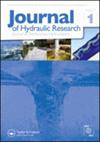地震加速度作用下溃坝的有限体积分析
IF 1.7
3区 工程技术
Q3 ENGINEERING, CIVIL
引用次数: 0
摘要
摘要由于在水力和地震力共同作用下发生的地震溃坝机制的复杂性,目前尚未得到单一的模型,本研究就是为了实现这一模型而进行的。本文采用流体体积法(VOF)模拟水通量,通用运动物体法(GMO)模拟运动体,流固耦合模型进行有限体积分析,研究了突发性和渐进式两种溃坝模型。为了保证计算结果的准确性,在研究溃坝机制之前,通过文献中的实验和数值研究对所采用的方法在溃坝情况下的验证进行了验证。本文以1967年12月11日发生的6.5级Koyna大坝地震为例进行了研究。对比两种破坏模式的溃坝输出流量,发现突发性破坏模式的峰值流量记录速度比渐进性破坏模式快3倍。另一个应该提到的成就是,虽然大的振荡周期带来了大坝体开裂的更高风险,但较小的周期会更快地传播产生的裂缝。关键词:洪水风险流体-颗粒相互作用水力模型湖泊与水库srans模型披露声明作者未报告潜在利益冲突。数据可用性声明本研究中提供的所有数值数据均可根据通讯作者的合理要求获得。公众可以在文章第一作者的博士论文中找到补充研究:https://hdl.handle.net/11511/93072本文章由计算机程序翻译,如有差异,请以英文原文为准。
Finite volume analysis of dam breaking subjected to earthquake accelerations
AbstractBecause of the complexity of the dam failure mechanism due to earthquakes that occur under the simultaneous influence of hydraulic and seismic forces, a single model has not been obtained so far and this study was conducted to achieve this model. In this paper, dam failure models including both sudden and gradual failure have been investigated using volume of fluid techniques (VOF) to simulate water fluxes, general moving object (GMO) to simulate moving bodies, and the fluid–structure interaction model for finite volume analysis. In order to be sure of the accuracy of the results, before examining the failure mechanisms, the verifications of utilized methods in the case of dam failure were proven using experimental and numerical studies from literature. The Koyna Dam earthquake of magnitude 6.5 (11 December 1967) is investigated as a test case. Comparison of the output discharges due to dam failure in the two failure models reveals that the peak discharge of sudden failure is recorded three times faster than the gradual failure mode. Another achievement that should be mentioned is that although large oscillating periods carry a higher risk of cracking of the dam’s body, smaller periods propagate the resulting cracks more rapidly.Keywords: Flood riskfluid–particle interactionshydraulic modelslakes and reservoirsRANS models Disclosure statementNo potential conflict of interest was reported by the author(s).Data availability statementAll numerical data presented in this study are available from the corresponding author upon reasonable request. Supplementary studies are available to the public at the following address in the doctoral dissertation of the first author of the article: https://hdl.handle.net/11511/93072
求助全文
通过发布文献求助,成功后即可免费获取论文全文。
去求助
来源期刊

Journal of Hydraulic Research
工程技术-工程:土木
CiteScore
4.90
自引率
4.30%
发文量
55
审稿时长
6.6 months
期刊介绍:
The Journal of Hydraulic Research (JHR) is the flagship journal of the International Association for Hydro-Environment Engineering and Research (IAHR). It publishes research papers in theoretical, experimental and computational hydraulics and fluid mechanics, particularly relating to rivers, lakes, estuaries, coasts, constructed waterways, and some internal flows such as pipe flows. To reflect current tendencies in water research, outcomes of interdisciplinary hydro-environment studies with a strong fluid mechanical component are especially invited. Although the preference is given to the fundamental issues, the papers focusing on important unconventional or emerging applications of broad interest are also welcome.
 求助内容:
求助内容: 应助结果提醒方式:
应助结果提醒方式:


